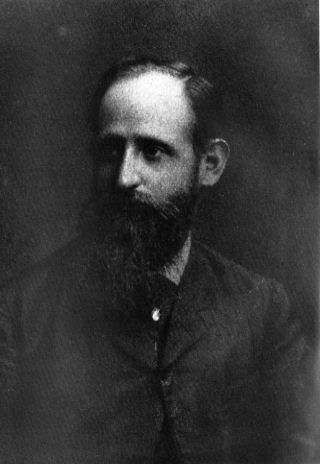<Back to Index>
- Physician Josef Breuer, 1842
- Writer Franz Seraphicus Grillparzer, 1791
- King of Saudi Arabia Abdul Aziz bin Saud, 1876
PAGE SPONSOR

Josef Breuer (January 15, 1842 Vienna – June 20, 1925 Vienna) was an Austrian physician whose works laid the foundation of psychoanalysis.
Born in Vienna, his father, Leopold Breuer, taught religion in Vienna's Jewish community.
Breuer's mother died when he was quite young, and he was raised by his
maternal grandmother and educated by his father until the age of eight.
He graduated from the Akademisches Gymnasium of Vienna in 1858 and then studied at the university for one year, before enrolling in the medical school of the University of Vienna. He passed his medical exams in 1867 and went to work as assistant to the internist Johann Oppolzer at the university. A close friend, mentor, and collaborator with Sigmund Freud, Breuer is perhaps best known for his work with Anna O. (the pseudonym of Bertha Pappenheim), a woman suffering from "paralysis of her limbs, and anaesthesias, as well as disturbances of vision and speech." Breuer
observed that her symptoms were reduced or disappeared after she
described them to him. Anna O. humorously called this procedure chimney sweeping. She also coined the more serious appellation for this form of therapy, "her talking cure," which is widely regarded as the basis of Freudian psychoanalysis. Ernest Jones considered: "Freud was greatly interested in hearing of the case of Anna O, which [...] made a deep impression on him"; and in his 1909 Five Lectures on Psycho - Analysis,
Freud generously pointed out: "I was a student and working for my final
examinations at the time when [...] Breuer, first (in 1880-2) made use
of this procedure. [...] Never before had anyone removed a hysterical
symptom by such a method." Freud and Breuer documented their discussions of Anna O., along with other case studies, in their 1895 book, Studies on Hysteria. These discussion of Breuer's treatment of Anna O. became "a formative basis of Freudian theory and psychoanalytic practice; especially the importance of fantasies (in extreme cases, hallucinations), hysteria [...], and the concept and method of catharsis which were Breuer's major contributions." The
two men became increasingly estranged at the same time, however, and
from a Freudian standpoint, "while Breuer, with his intelligent and
amorous patient Anna O., had unwittingly laid the groundwork for
psychoanalysis, it was Freud who drew the consequences from Breuer's
case.". Breuer, working under Ewald Hering at the military medical school in Vienna, was the first to demonstrate the role of the vagus nerve in
the reflex nature of respiration. This was a departure from previous
physiological understanding, and changed the way scientists viewed the
relationship of the lungs to the nervous system. The mechanism is now
known as the Hering – Breuer reflex. Independent of each other in 1873, Breuer and the physicist and mathematician Ernst Mach discovered
how the sense of balance (i.e., the perception of the head’s imbalance)
functions: that it is managed by information the brain receives from
the movement of a fluid in the semicircular canals of the inner ear. That the sense of balance depends on the three semicircular canals was discovered in 1870 by the physiologist Friedrich Goltz, but Goltz did not discover how the balance sensing apparatus functions. In 1894, Breuer was elected a Corresponding Member of the Vienna Academy of Science.
Breuer
married Mathilde Altmann in 1868, and they had five children. His
daughter Dora later committed suicide rather than be deported by the
Nazis. Likewise, one of his granddaughters died at their hands. A series of meetings between Josef Breuer and Friedrich Nietzsche was fictionally created in the book When Nietzsche Wept by Irvin D. Yalom. The 1968 TV film Prescription: Murder, which introduced the character of Columbo, begins with the murderer (Gene Barry), an arrogant psychiatrist, stumping party guests in a game of Botticelli by choosing Josef Breuer. In
1992, the relationship between Josef Breuer and Anna O. was
fictionalized in the play "The Mystery of Anna O". Spanning 3 time
periods, the play questions whether Anna O was actually Bertha
Pappenheim. The play was written by Jerome Coopersmith. He appears as a minor character in Joseph Skibell's 2010 novel, A Curable Romantic. He is also an important character in the first version of Jean - Paul Sartre's The Freud Scenario, a script director John Huston asked
him to write for a film about the years in which Freud began to develop his psychoanalytical theory. The resulting film was Freud: The Secret Passion, but Sartre's script was never used. When Nietzsche Wept is
an independent film released in 2007, starring Armand Assante, Ben
Cross and Katheryn Winnick. The movie is based on a book of the same
name by Irvin D. Yalom and was directed by Pinchas Perry.
The
film follows the storyline of the book quite faithfully, although
neither the book nor the movie is based entirely on reality. Although
the main characters and some of the facts are true, the center piece of
the novel (and of the movie), which was the therapeutic encounter of
German philosopher Friedrich Nietzsche and Austrian physician Josef
Breuer, never happened.